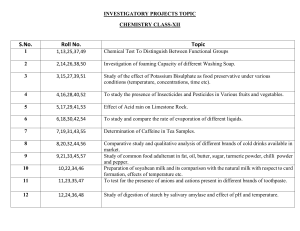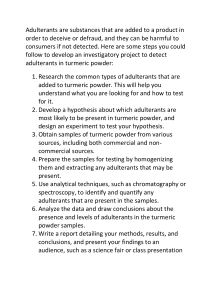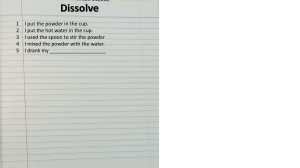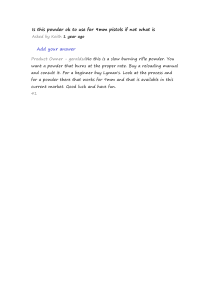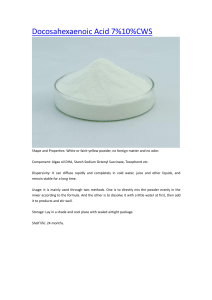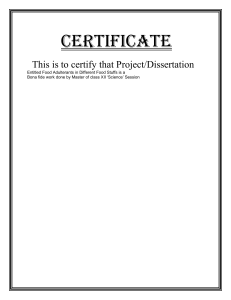Food Adulteration Detection: Physical-Chemical Tests
advertisement
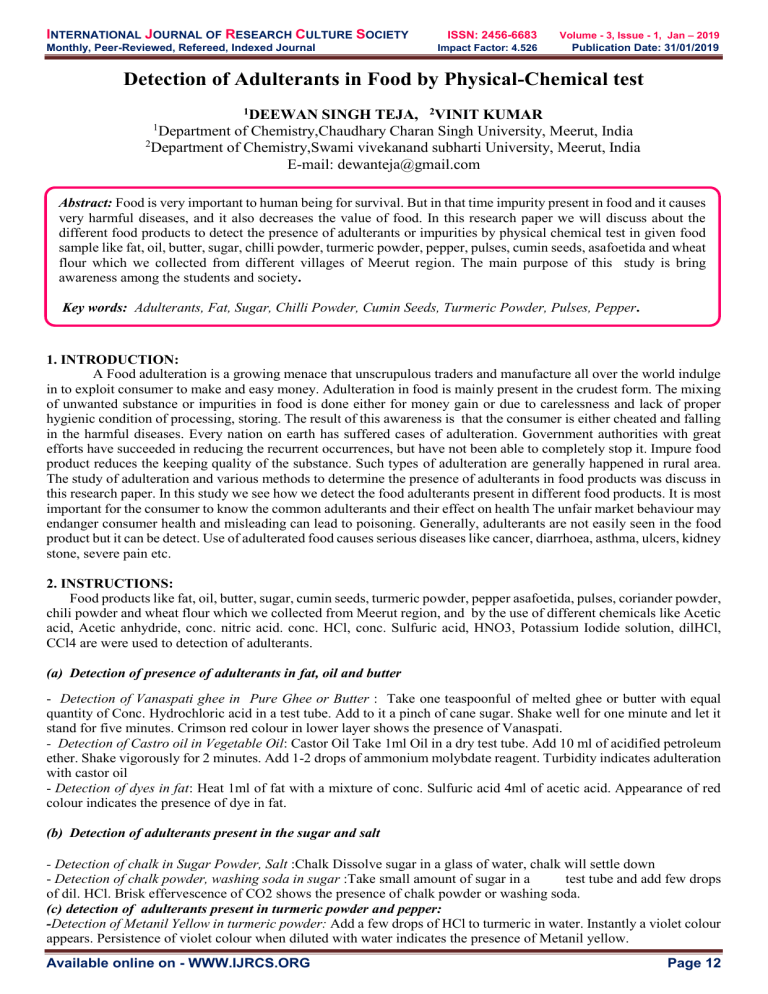
INTERNATIONAL JOURNAL OF RESEARCH CULTURE SOCIETY Monthly, Peer-Reviewed, Refereed, Indexed Journal ISSN: 2456-6683 Volume - 3, Issue - 1, Jan – 2019 Impact Factor: 4.526 Publication Date: 31/01/2019 Detection of Adulterants in Food by Physical-Chemical test 1DEEWAN SINGH TEJA, 2VINIT KUMAR Department of Chemistry,Chaudhary Charan Singh University, Meerut, India 2 Department of Chemistry,Swami vivekanand subharti University, Meerut, India E-mail: dewanteja@gmail.com 1 Abstract: Food is very important to human being for survival. But in that time impurity present in food and it causes very harmful diseases, and it also decreases the value of food. In this research paper we will discuss about the different food products to detect the presence of adulterants or impurities by physical chemical test in given food sample like fat, oil, butter, sugar, chilli powder, turmeric powder, pepper, pulses, cumin seeds, asafoetida and wheat flour which we collected from different villages of Meerut region. The main purpose of this study is bring awareness among the students and society. Key words: Adulterants, Fat, Sugar, Chilli Powder, Cumin Seeds, Turmeric Powder, Pulses, Pepper. 1. INTRODUCTION: A Food adulteration is a growing menace that unscrupulous traders and manufacture all over the world indulge in to exploit consumer to make and easy money. Adulteration in food is mainly present in the crudest form. The mixing Key Words: of unwanted substance or impurities in food is done either for money gain or due to carelessness and lack of proper hygienic condition of processing, storing. The result of this awareness is that the consumer is either cheated and falling in the harmful diseases. Every nation on earth has suffered cases of adulteration. Government authorities with great efforts have succeeded in reducing the recurrent occurrences, but have not been able to completely stop it. Impure food product reduces the keeping quality of the substance. Such types of adulteration are generally happened in rural area. The study of adulteration and various methods to determine the presence of adulterants in food products was discuss in this research paper. In this study we see how we detect the food adulterants present in different food products. It is most important for the consumer to know the common adulterants and their effect on health The unfair market behaviour may endanger consumer health and misleading can lead to poisoning. Generally, adulterants are not easily seen in the food product but it can be detect. Use of adulterated food causes serious diseases like cancer, diarrhoea, asthma, ulcers, kidney stone, severe pain etc. 2. INSTRUCTIONS: Food products like fat, oil, butter, sugar, cumin seeds, turmeric powder, pepper asafoetida, pulses, coriander powder, chili powder and wheat flour which we collected from Meerut region, and by the use of different chemicals like Acetic acid, Acetic anhydride, conc. nitric acid. conc. HCl, conc. Sulfuric acid, HNO3, Potassium Iodide solution, dilHCl, CCl4 are were used to detection of adulterants. (a) Detection of presence of adulterants in fat, oil and butter - Detection of Vanaspati ghee in Pure Ghee or Butter : Take one teaspoonful of melted ghee or butter with equal quantity of Conc. Hydrochloric acid in a test tube. Add to it a pinch of cane sugar. Shake well for one minute and let it stand for five minutes. Crimson red colour in lower layer shows the presence of Vanaspati. - Detection of Castro oil in Vegetable Oil: Castor Oil Take 1ml Oil in a dry test tube. Add 10 ml of acidified petroleum ether. Shake vigorously for 2 minutes. Add 1-2 drops of ammonium molybdate reagent. Turbidity indicates adulteration with castor oil - Detection of dyes in fat: Heat 1ml of fat with a mixture of conc. Sulfuric acid 4ml of acetic acid. Appearance of red colour indicates the presence of dye in fat. (b) Detection of adulterants present in the sugar and salt - Detection of chalk in Sugar Powder, Salt :Chalk Dissolve sugar in a glass of water, chalk will settle down - Detection of chalk powder, washing soda in sugar :Take small amount of sugar in a test tube and add few drops of dil. HCl. Brisk effervescence of CO2 shows the presence of chalk powder or washing soda. (c) detection of adulterants present in turmeric powder and pepper: -Detection of Metanil Yellow in turmeric powder: Add a few drops of HCl to turmeric in water. Instantly a violet colour appears. Persistence of violet colour when diluted with water indicates the presence of Metanil yellow. Available online on - WWW.IJRCS.ORG Page 12 INTERNATIONAL JOURNAL OF RESEARCH CULTURE SOCIETY Monthly, Peer-Reviewed, Refereed, Indexed Journal ISSN: 2456-6683 Volume - 3, Issue - 1, Jan – 2019 Impact Factor: 4.526 Publication Date: 31/01/2019 - Detection of aniline dyes in turmeric powder: Take some turmeric powder in a test-tube and add water to make a solution. Add 1 to 2 ml of rectified spirit. An immediate separation of yellow colour in the rectified spirit will indicate the presence of added dyes. - Detection of papaya seed in Black Pepper: Papaya Seeds Float the sample in alcohol. The mature black pepper berries sink while papaya seeds and light black pepper float - Detection of papaya seed in pepper - Take small amount of sample of pepper to beaker containing water and stir with a glass rod. Dried papaya seeds being lighter float over water while pure pepper settled at the bottom. (d) Detection of adulterants present in red chilli powder - Detection of Brick Powder in red chilli powder: settles fast chilli powder settles slowly when put in water. - Detection of Red Colour dye in red chilli powder: Sprinkle some Chilli powder on the surface of water in a glass beaker. Artificial colorants will descend as coloured streaks. -Detection of Sudan red III colour in red chilli powder: Take 1 g of suspected chilli powder in a test-tube, add 2 ml of hexane to it, and shake well. Allow it to settle. Decant the clear solution into another test tube. Add 2 ml of aceto-nitrile reagent in water (7:3) and shake well. The appearance of a red colour in the lower aceto-nitrile layer indicates the presence of Sudan red III - Detection of red lead salts in red chilli powder - To a sample of chilli powder add dil. HNO3. Filter the solution add 2 drops of potassium iodide solution to the filtrate. Yellow ppt. obtained indicates the presence of lead salts in chilli powder. (e) Detection of adulterants in pulses - Detection of Metanil Yellow or Lead Chromate in pulses :Extract the colour with luke warm water from the sample of pulses. Add drops of HCl. A pink colour indicates presence of Metanil yellow / Lead Chromate. (f) Adulterants of Asafoetida - Detection of Soap stone in Asafoetida: Shake the little quantity of powdered sample with water some heavy particle like soap stone or earthy matter settled at the bottom - Detection of Colophon residue obtained after the distillation of turpentine oil in Asafoetida: Take 1 g of asafoetida, powder it thoroughly, and take it in a test-tube. Add some rectified spirit and filter/ decant the solution. Take 5 ml of filtrate and add few drops of ferric chloride (6%) solution. Olive green colour shows the presence of adulteration with other resins. We take a different food product and analysed that refer table given below: S. No Food Sample Adulterants Inference 1 asafoetida Colophon residue obtained after the Olive green colour is appear distillation of turpentine oil Soap stone It settle down 2 Tea Iron filling No found 3 Turmeric powder Metanil yellow Violet colour persist Aniline dye Yellow colour persist 4 Sugar Washing soda No Briskeffervences observed Chalk powder No powder settle down 5 Vegetable oil Castro Oil Turbidity appear 6 Red chilli Red lead salts Light yellow ppt is observed Brick powder It settle down Sudan red III Red colour is appear 7 Pure ghee Vanaspati ghee Crimson red coloured is observed 8 Pepper Papaya seed No Dried Float over water 9 Pulses Metanil yellow/lead chromate Pink colour 4. RESULT: We take this food sample in the Meerut region. The physical and chemical test which is listed above are performed in the laboratory, by the help of the test we ensure that the supplier mixed the adulterants in the food product for gain more money. Appearance of colour, change in colour, and formation of ppt., evolution of gas and floating of foreign particles over the surface of food sample and the water surface has been given above in the table: Available online on - WWW.IJRCS.ORG Page 13 INTERNATIONAL JOURNAL OF RESEARCH CULTURE SOCIETY Monthly, Peer-Reviewed, Refereed, Indexed Journal ISSN: 2456-6683 Volume - 3, Issue - 1, Jan – 2019 Impact Factor: 4.526 Publication Date: 31/01/2019 5. CONCLUSION: The adulterants found in the food product of Meerut region. The main moto of the study to give an awareness to the people to buy good and best product and if any case, we have a doubt that the product contains any prohibited colouring matter, preservatives, or contains any permitted colouring matter or preservative in excess of the prescribed limits, then as the Indian we have right to file a report against the supplier. REFERENCES: 1. S. Abhirami and R. Radha, “Detection of food adulteration in selected food items procured by homemaker,” Int. J. Recent Scientific Research, vol. 6, 5938-5943, 2015 2. S. Awasthi, K Jain., A. Das, R. Alam, G. Surti and N. Kishan, “Analysis of food quality and food adulterants from different departmental and local grocery stores by qualitative analysis for food safety,” IOSR J. Environmental Science Toxicology and Food Technology, vol. 8, 22-26, 2014. 3. “Identifying the common adulterants in food” by Dr. Sitaram Dixit - Consumer Guidance Society of India. 4. The guidelines of the “Food Safety and Standards Authority of India.” 5. H. Faizunisa, Vaishnavi, I. Priyadarshini, P. Chaly, “Evaluation of food adulteration among selected food items-In vitro study,” Int. J. Health Sciences and Research, vol.6, 129-145, 2016. 6. Dipak and Dash, “Nationwide survey to check food adulteration,” Department of food adulterations (2014). Available online on - WWW.IJRCS.ORG Page 14
